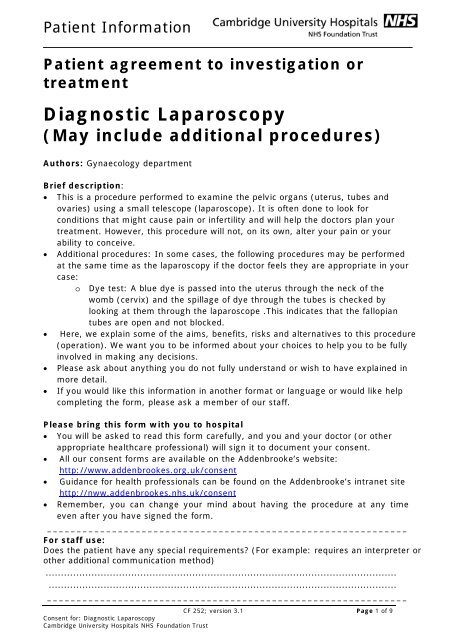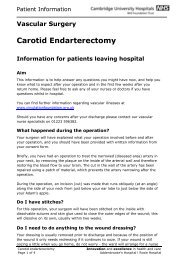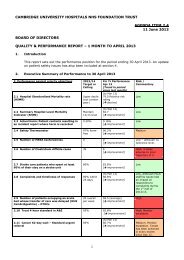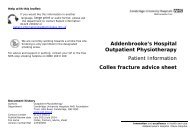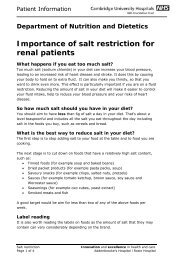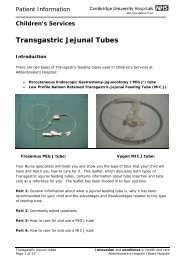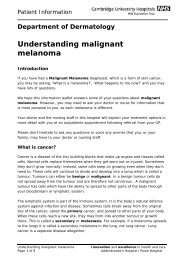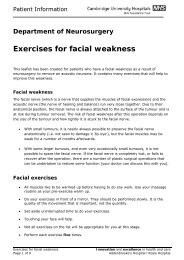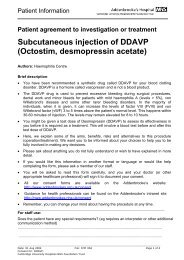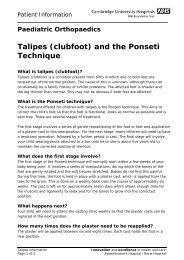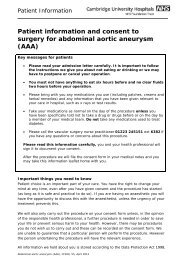Diagnostic Laparoscopy - Cambridge University Hospitals
Diagnostic Laparoscopy - Cambridge University Hospitals
Diagnostic Laparoscopy - Cambridge University Hospitals
You also want an ePaper? Increase the reach of your titles
YUMPU automatically turns print PDFs into web optimized ePapers that Google loves.
Patient Information<br />
Patient agreement to investigation or<br />
treatment<br />
<strong>Diagnostic</strong> <strong>Laparoscopy</strong><br />
(May include additional procedures)<br />
Authors: Gynaecology department<br />
Brief description:<br />
• This is a procedure performed to examine the pelvic organs (uterus, tubes and<br />
ovaries) using a small telescope (laparoscope). It is often done to look for<br />
conditions that might cause pain or infertility and will help the doctors plan your<br />
treatment. However, this procedure will not, on its own, alter your pain or your<br />
ability to conceive.<br />
• Additional procedures: In some cases, the following procedures may be performed<br />
at the same time as the laparoscopy if the doctor feels they are appropriate in your<br />
case:<br />
o Dye test: A blue dye is passed into the uterus through the neck of the<br />
womb (cervix) and the spillage of dye through the tubes is checked by<br />
looking at them through the laparoscope .This indicates that the fallopian<br />
tubes are open and not blocked.<br />
• Here, we explain some of the aims, benefits, risks and alternatives to this procedure<br />
(operation). We want you to be informed about your choices to help you to be fully<br />
involved in making any decisions.<br />
• Please ask about anything you do not fully understand or wish to have explained in<br />
more detail.<br />
• If you would like this information in another format or language or would like help<br />
completing the form, please ask a member of our staff.<br />
Please bring this form with you to hospital<br />
• You will be asked to read this form carefully, and you and your doctor (or other<br />
appropriate healthcare professional) will sign it to document your consent.<br />
• All our consent forms are available on the Addenbrooke’s website:<br />
http://www.addenbrookes.org.uk/consent<br />
• Guidance for health professionals can be found on the Addenbrooke’s intranet site<br />
http://nww.addenbrookes.nhs.uk/consent<br />
• Remember, you can change your mind about having the procedure at any time<br />
even after you have signed the form.<br />
_____________________________________________________________<br />
For staff use:<br />
Does the patient have any special requirements? (For example: requires an interpreter or<br />
other additional communication method)<br />
...................................................................................................................<br />
..................................................................................................................<br />
_____________________________________________________________<br />
CF 252; version 3.1 Page 1 of 9<br />
Consent for: <strong>Diagnostic</strong> <strong>Laparoscopy</strong><br />
<strong>Cambridge</strong> <strong>University</strong> <strong>Hospitals</strong> NHS Foundation Trust
Patient Information<br />
About <strong>Diagnostic</strong> <strong>Laparoscopy</strong><br />
The aim is to use key-hole surgery (using a laparoscope/small telescope) to examine the<br />
outside of the uterus (womb), ovaries and fallopian tubes.<br />
Before your procedure<br />
• You will be seen at the pre-admission outpatient’s clinic by the pre-admission<br />
sisters and usually you will see one of the consultants or senior trainees. If<br />
admitted as an emergency, you will not go through the pre-admission process.<br />
• At this clinic, we shall ask you for details of your medical history and carry out any<br />
necessary clinical examinations and investigations. This is a good opportunity for<br />
you to ask us any questions about the procedure, but please feel free to discuss<br />
any concerns you might have at any time.<br />
• You will be asked if you are taking any tablets or other types of medication - these<br />
might be ones prescribed by a doctor or bought over the counter in a pharmacy. It<br />
helps us if you bring details with you of anything you are taking (for example:<br />
bring the packaging with you).<br />
• This procedure involves the use of general anaesthesia. See below for further<br />
details about the types of anaesthesia we shall use. In addition, we will use local<br />
anaesthetic to reduce your post-operative discomfort.<br />
• Most people who have this type of procedure will not need to stay in hospital and<br />
will be able to go home the same day. You will be admitted on the day of surgery.<br />
Sometimes we can predict whether you will need to stay for longer than usual -<br />
your doctor will discuss this with you before you decide to have the procedure.<br />
During the procedure (operation/treatment) itself<br />
• Before your procedure, you will be given the necessary anaesthetic - see below for<br />
details of this.<br />
• There will be two or three incisions (cuts) made that you can see. The first is for<br />
the telescope and is inside the navel (belly button). This is approximately 1 cm<br />
long. One or two further cuts will be made in the lower half of your abdomen<br />
(tummy), which are approximately 5 mm long.<br />
• Small dissolvable stitches are usually used to close the small skin wounds at the<br />
end of the operation; these don’t need to be removed.<br />
After the procedure (operation/treatment)<br />
• If you have had a general anaesthetic you will wake up in the recovery room after<br />
your operation. You might have an oxygen mask on your face to help you breathe.<br />
You might also wake up feeling sleepy.<br />
• After this procedure, most people will have a small, plastic tube in one of the veins<br />
of their arm. This might be attached to a bag of fluid (called a drip), which feeds<br />
your body with fluid until you are well enough to eat and drink by yourself.<br />
• While you are in the recovery room, a nurse will check your pulse and blood<br />
pressure regularly they will also check the wound sites and monitor any vaginal<br />
bleeding you may have. When you are well enough to be moved, you will be taken<br />
to a ward.<br />
CF 252; version 3.1 Page 2 of 9<br />
Consent for: <strong>Diagnostic</strong> <strong>Laparoscopy</strong><br />
<strong>Cambridge</strong> <strong>University</strong> <strong>Hospitals</strong> NHS Foundation Trust
Patient Information<br />
• Sometimes, people feel sick after an operation, especially after a general<br />
anaesthetic, and might vomit. If you feel sick, please tell a nurse and you will be<br />
offered medicine to make you more comfortable.<br />
• Eating and drinking: Usually following surgery you will be able to drink fluids<br />
when you are ready. If you feel hungry, you can usually have something light to<br />
eat soon after the operation.<br />
• Getting around and about: After this procedure, we will try to get you mobile<br />
(up and about) as soon as we can to help prevent complications from lying in bed.<br />
• When you can leave hospital: The actual time that you stay in hospital will<br />
depend on how quickly you recover from your operation and the type of operation<br />
you have had. Often it will be possible for you to return home on the day of<br />
surgery but on occasions you may need to stay longer. If you have problems with<br />
the recovery from the operation or require further treatment you might need to<br />
stay in for longer.<br />
• When you can resume normal activities including work: You can usually<br />
resume normal activities including beginning gentle work within 48 hours after<br />
your operation. Often you will want to wait a little longer before resuming more<br />
vigorous activity. You may drive 48 hours after the procedure if you feel<br />
comfortable.<br />
• Check-ups and results: You will be given information about the results of your<br />
surgery after the operation. Follow up management will be discussed with you<br />
depending on the examination findings. The follow-up is tailored to your<br />
requirements, and a clinic appointment will be sent if appropriate.<br />
Intended benefits of the procedure<br />
We aim to find the cause of pain and / or infertility and to plan treatment of your<br />
symptoms.<br />
Who will perform my procedure?<br />
• This procedure will be performed by a consultant gynaecologist or a junior doctor<br />
training in this field and working under supervision.<br />
Alternative procedures that are available<br />
• The alternative to this surgery is to decide not to have surgery and the<br />
implications of deciding not to have surgery will be discussed with you.<br />
Serious or frequently occurring risks<br />
If you have a pre-existing medical condition, are obese, have significant pathology or<br />
have had previous surgery the quoted risks for serious or frequent complications will<br />
be increased. The risk of serious complications at laparoscopy also increases if an<br />
additional therapeutic procedure is performed. You are advised that laparoscopy may<br />
not identify an obvious cause for presenting complaint.<br />
The table below is designed to help you understand the risks associated with this type<br />
of surgery (based on the RCOG Clinical Governance Advice, Presenting Information on Risk)<br />
CF 252; version 3.1 Page 3 of 9<br />
Consent for: <strong>Diagnostic</strong> <strong>Laparoscopy</strong><br />
<strong>Cambridge</strong> <strong>University</strong> <strong>Hospitals</strong> NHS Foundation Trust
Patient Information<br />
Term Equivalent<br />
ratio<br />
numerical Colloquial equivalent<br />
Very common 1/1 to 1/10 A person in family<br />
Common 1/10 to 1/100 A person in street<br />
Uncommon 1/100 to 1/1000 A person in village<br />
Rare 1/1000 to 1/10 000 A person in small town<br />
Very rare Less than 1/10 000 A person in large town<br />
Serious risks include:<br />
• the overall risk of serious complications from diagnostic laparoscopy,<br />
approximately two women in every 1 000 (uncommon)<br />
• damage to bowel, bladder, uterus or major blood vessels which would require<br />
immediate repair by laparoscopy or laparotomy (making an open incision in the<br />
tummy) (< 1%, uncommon). Up to 15% of bowel injuries may not be diagnosed at<br />
the time of laparoscopy<br />
• failure to gain entry to abdominal cavity and to complete intended procedure<br />
• hernia at site of entry<br />
• death; three to eight women in every 100 000 undergoing laparoscopy die as a<br />
result of complications (very rare).<br />
Frequent risks include:<br />
• wound bruising<br />
• shoulder-tip pain<br />
• wound gaping<br />
• wound infection<br />
Any extra procedures which may become necessary during the procedure:<br />
• Laparotomy (opening up of the tummy)<br />
• Repair of damage to bowel, bladder, uterus or blood vessels<br />
• Blood transfusion.<br />
Information and support<br />
You might be given some additional patient information before or after the procedure,<br />
for example leaflets that explain what to do after the procedure and what problems to<br />
look out for. If you have any questions or anxieties, please feel free to ask a member<br />
of staff.<br />
In addition we would recommend your following the link below to access the Royal<br />
College of Obstetricians and Gynaecologists post operative advice on laparoscopy:<br />
http://www.rcog.org.uk/recovering-well<br />
• Pre Admissions Sisters<br />
Monday to Friday 07:00 to 14:30 hours<br />
Telephone 01223 586847 (internal ext 6847)<br />
E-mail: preadmission.nurses@addenbrookes.nhs.uk<br />
CF 252; version 3.1 Page 4 of 9<br />
Consent for: <strong>Diagnostic</strong> <strong>Laparoscopy</strong><br />
<strong>Cambridge</strong> <strong>University</strong> <strong>Hospitals</strong> NHS Foundation Trust
Patient Information<br />
The Pre Admission Sisters will be available in the office between 07:00 to 09:00<br />
hours. Otherwise please leave a message on the machine and your call will be<br />
returned.<br />
For post operative advice and concerns please contact the staff on:<br />
• Daphne Ward<br />
01223 217636<br />
08:00 – 20:00 Monday to Friday<br />
08:30 – 14:30 Saturdays and Sundays<br />
Closed Bank holidays<br />
• Inpatient Gynaecology Ward<br />
01223 348544<br />
At all other times<br />
Your anaesthesia<br />
General anaesthesia<br />
During general anaesthesia you are put into a state of unconsciousness and you will<br />
be unaware of anything during the time of your operation. Your anaesthetist achieves<br />
this by giving you a combination of drugs.<br />
Before your operation<br />
Before your operation your anaesthetist will visit you in the ward, although<br />
occasionally this will happen in a pre-anaesthetic assessment clinic. If you are a day<br />
case patient it may not be until just before your operation. The anaesthetist who looks<br />
after you on the day of your operation is the one who is responsible for making the<br />
final decisions about your anaesthetic. He or she will need to understand about your<br />
general health, any medication that you are taking and any past health problems that<br />
you have had. Your anaesthetist will want to know whether or not you are a smoker,<br />
whether you have had any abnormal reactions to any of the drugs or if you have any<br />
allergies. They will also want to know about your teeth, whether you wear dentures,<br />
have caps or a plate. Your anaesthetist needs to know all these things so that he or<br />
she can assess how to look after you in this vital period. Your anaesthetist may<br />
examine your heart and lungs and may also prescribe medication that you will be<br />
given shortly before your operation, the pre-medication or 'pre-med'.<br />
Pre-medication is the name given to medication (drugs) given to you some hours<br />
before your operation. These drugs may be given as tablets, injections or liquids (to<br />
children). They relax you and may send you to sleep. They are not always given.<br />
Do not worry if you do not have a pre-med, your anaesthetist has to take many<br />
factors into account in making this decision and will take account of your views on the<br />
topic if possible. Do not be worried about your anaesthetic. When your anaesthetist<br />
visits you before your operation, this is the time to ask all the questions that you may<br />
have, so that you can forget your fears and worries.<br />
CF 252; version 3.1 Page 5 of 9<br />
Consent for: <strong>Diagnostic</strong> <strong>Laparoscopy</strong><br />
<strong>Cambridge</strong> <strong>University</strong> <strong>Hospitals</strong> NHS Foundation Trust
Patient Information<br />
Before your operation you will usually be changed into a gown and wheeled to the<br />
operating suite into an anaesthetic room. This is an ante-room outside the theatre.<br />
The anaesthetist, his or her assistant and nurses are likely to be present. An<br />
intravenous line (drip) may be inserted. Monitoring devices may be attached to you,<br />
such as a blood pressure cuff or a pulse oximeter. A pulse oximeter is usually a little<br />
red light in a small box, which is taped to your finger. It shows how much oxygen you<br />
have in your blood and is one of the vital monitors that an anaesthetist uses during<br />
your operation to ensure that you remain in the best of health. You may be given<br />
some oxygen to breathe. It is common practice nowadays to allow a parent into the<br />
anaesthetic room with children: as the child goes unconscious, the parent will usually<br />
be asked to leave.<br />
During your operation<br />
While you are unconscious and unaware your anaesthetist remains with you at all<br />
times. He or she monitors your condition and administers the right amount of<br />
anaesthetic drugs to maintain you in the correct level of unconsciousness for the<br />
period of the surgery. Your anaesthetist is constantly aware of your condition and<br />
trained to respond. Your anaesthetist will be monitoring such factors as heart rate,<br />
blood pressure, heart rhythm, body temperature and breathing. He or she will also<br />
constantly watch your need for fluid or blood replacement. If you have any other<br />
medical conditions, your anaesthetist will know of these from your pre-operative<br />
assessment and be able to treat them during surgery.<br />
After your operation<br />
After your operation your anaesthetist continues to monitor your condition carefully.<br />
You will probably be transferred to a recovery ward where specially trained nurses,<br />
under the direction of anaesthetists, will look after you. Your anaesthetist and the<br />
recovery nurses will ensure that all the anaesthetic effects are reversed and that you<br />
are closely monitored as you return to full consciousness. You may be given some<br />
oxygen to breathe in the recovery area, and may find that intravenous drips have<br />
been inserted whilst you are unconscious in theatre and that these will be replacing<br />
fluids that you might require. You will be given medication for any pain that you might<br />
feel, and systems, such as Patient Controlled Analgesia (PCA) may be set up to<br />
continue pain control on the ward.<br />
You are likely to feel drowsy and sleepy at this stage. Some patients feel sick; others<br />
may have a sore throat related to the insertion of the breathing tube during surgery.<br />
During this time it is important that you relax as much as you can, breathe deeply, do<br />
not be afraid to cough, and do not hesitate to ask the nursing staff for any pain relief,<br />
and about any queries you may have. You are likely to have hazy memories of this<br />
time and some patients experience vivid dreams. Once you are fully awake you will be<br />
returned to the ward.<br />
CF 252; version 3.1 Page 6 of 9<br />
Consent for: <strong>Diagnostic</strong> <strong>Laparoscopy</strong><br />
<strong>Cambridge</strong> <strong>University</strong> <strong>Hospitals</strong> NHS Foundation Trust
Patient Information<br />
What are the risks of general anaesthesia?<br />
In modern anaesthesia, serious problems are uncommon. Risks cannot be removed<br />
completely, but modern equipment, training and drugs have made it a much safer<br />
procedure in recent years. The risk to you as an individual will depend on; whether you<br />
have any other illness, personal factors (such as smoking or being overweight) or surgery<br />
which is complicated, long or done in an emergency. Please discuss any pre-existing<br />
medical condition with your anaesthetist.<br />
•<br />
•<br />
•<br />
Very common and common side effects (1 in 10 or 1 in 100 people)<br />
Feeling sick and vomiting after surgery, sore throat, dizziness, blurred vision, headache,<br />
itching, aches, pains and backache, pain during injection of drugs, bruising and<br />
soreness, confusion or memory loss.<br />
Uncommon side effects and complications (1 in 1000 people)<br />
Chest infection, bladder problems, muscle pains, slow breathing (depressed<br />
respiration), damage to teeth, lips or tongue, an existing medical condition getting<br />
worse, awareness (becoming conscious during your operation).<br />
Rare or very rare complications (1 in 10,000 or 1 in 100,000)<br />
Damage to the eyes, serious allergy to drugs, nerve damage, death, equipment failure.<br />
Local anaesthesia<br />
In local anaesthesia the local anaesthetic drug is injected into the skin and tissues at<br />
the site of the operation. The area of numbness will be restricted and some sensation<br />
of pressure may be present, but there should be no pain. Usually a local anaesthetic<br />
will be given by the doctor doing the operation.<br />
We are currently working towards a smoke free site. Smoking is only<br />
permitted in the designated smoking areas.<br />
For advice and support in quitting, contact your GP or the free NHS stop<br />
smoking helpline on 0800 169 0 169<br />
Help with this leaflet:<br />
If you would like this information in another language, large<br />
print or audio format, please ask the department to contact<br />
Patient Information: 01223 216032 or<br />
patient.information@addenbrookes.nhs.uk<br />
Document history<br />
Authors Gynaecology Department<br />
Department <strong>Cambridge</strong> <strong>University</strong> <strong>Hospitals</strong> NHS Foundation Trust, Hills Road,<br />
<strong>Cambridge</strong>, CB2 0QQ www.cuh.org.uk<br />
Contact number 01223 217755<br />
Publish/Review date October 2011/October 2014 (minor amendment made November<br />
2011)<br />
File name <strong>Diagnostic</strong>_laparoscopy.doc<br />
Version number/Ref 3.1/CF252<br />
CF 252; version 3.1 Page 7 of 9<br />
Consent for: <strong>Diagnostic</strong> <strong>Laparoscopy</strong><br />
<strong>Cambridge</strong> <strong>University</strong> <strong>Hospitals</strong> NHS Foundation Trust
Consent form 1<br />
Patient agreement to<br />
investigation or treatment<br />
Special requirements<br />
(For example, other language/other communication method)<br />
Name of proposed procedure or course of treatment<br />
<strong>Diagnostic</strong> <strong>Laparoscopy</strong><br />
<strong>Laparoscopy</strong> and dye test<br />
Addenbrooke’s Hospital<br />
For staff use only:<br />
Surname:<br />
First names:<br />
Date of birth:<br />
Hospital no:<br />
Male/Female:<br />
(Use hospital identification label)<br />
Responsible health professional/job title<br />
Statement of health professional<br />
(To be filled in by a health professional with an appropriate knowledge of the proposed<br />
procedure, as specified in the Hospital’s consent policy)<br />
I have explained the procedure to the patient. In particular, I have explained:<br />
• The intended benefits of the procedure: As outlined in the attached document<br />
• Any serious or frequently occurring risks from the procedures including those specific to<br />
the patient: As outlined in the attached document<br />
• Any extra procedures that might become necessary during the procedure<br />
Blood transfusion Other procedure (please specify) ..................................................<br />
I have discussed what the treatment / procedure is likely to involve, the benefits and risks of any<br />
available alternative treatments (including no treatment) and any particular concerns of this patient.<br />
• The following information leaflet has been provided: <strong>Diagnostic</strong> <strong>Laparoscopy</strong> ................<br />
Version/Date/Ref: 3.1/October 2011/CF252....................<br />
This procedure will involve:<br />
General and/or regional anaesthesia Local anaesthesia Sedation<br />
Health professional’s signature: …………………………………………………………..Date: ……………………………<br />
Name (PRINT): …………………………………………………………….. Job title: …………………………..…………………<br />
Contact details (if patient wishes to discuss details later)<br />
I have offered the patient information about the procedure but s/he has declined information.<br />
Statement of the interpreter (if appropriate)<br />
I have interpreted the information to the best of my ability, and in a way in which I believe s/he<br />
can understand:<br />
Interpreter’s signature.............................................................. Date: ..............................<br />
Name (PRINT):........................................................................<br />
Important notes: (tick if applicable)<br />
The patient has withdrawn consent (ask patient to sign/date here) ................................<br />
See also advance directive/living will<br />
Copy accepted by patient: yes / no (please circle)<br />
CF 252; version 3.1 Page 8 of 9<br />
Consent for: <strong>Diagnostic</strong> <strong>Laparoscopy</strong><br />
<strong>Cambridge</strong> <strong>University</strong> <strong>Hospitals</strong> NHS Foundation Trust
Statement of patient<br />
Please read this form carefully. If your treatment has been<br />
planned in advance, you should already have your own copy,<br />
which describes the benefits and risks of the proposed treatment.<br />
Addenbrooke’s Hospital<br />
For staff use only:<br />
Surname:<br />
First names:<br />
Date of birth:<br />
Hospital no:<br />
Male/Female:<br />
(Use hospital identification label)<br />
If not, you will be offered a copy now. Do ask if you have any further<br />
questions. The staff at Addenbrooke’s are here to help you. You have the right to change your mind at<br />
any time before the procedure is undertaken, including after you have signed this form.<br />
Training doctors and other health professionals is essential to the continuation of the Health Service and<br />
improving the quality of care. Your treatment may provide an important opportunity for such training, where<br />
necessary under the careful supervision of a senior doctor. You may, however, decline to be involved in the<br />
formal training of medical and other students without this adversely affecting your care and treatment.<br />
Please read the following:<br />
I understand that I will have the opportunity to discuss the details of anaesthesia with an<br />
anaesthetist before the procedure, unless the urgency of my situation prevents this. (This only<br />
applies to patients having general or regional anaesthesia.)<br />
I understand that you cannot give me a guarantee that a particular person will perform the<br />
procedure. The person undertaking the procedure will, however, have appropriate experience.<br />
I understand that any procedure in addition to those described on this form will only be<br />
carried out if it is necessary to save my life or to prevent serious harm to my health.<br />
I have been told about additional procedures which may become necessary during my<br />
treatment. I have listed below any procedures that I do not wish, without further<br />
discussion, to be carried out.<br />
I understand that any tissue (including blood) removed as part of the procedure or<br />
treatment will be anonymised and may be used for teaching or quality control, and stored or<br />
disposed of in a manner regulated by appropriate, ethical, legal and professional standards.<br />
I understand that all research will be approved by a research ethics committee and<br />
undertaken in accordance with appropriate ethical, legal and professional standards.<br />
I understand that the research may be conducted within a hospital, university, not for profit<br />
organisation or a company laboratory.<br />
Please tick boxes to indicate you either agree/disagree to the three points below. Yes No<br />
I agree that tissue (including blood) not needed for my own diagnosis or treatment can be<br />
used for research which may include genetic research. If you wish to withdraw your<br />
consent for the use of your tissue (including blood) for research, please contact the Patient<br />
Advice and Liaison Service at Addenbrooke's Hospital.<br />
I agree to the use of photography for the purpose of diagnosis and treatment.<br />
I agree to anonymised photographs being used for medical teaching.<br />
I confirm that the risks, benefits and alternatives of this procedure have been discussed<br />
with me and I have read and understood the above and agree to the procedure (or course of<br />
treatment) on this form.<br />
Patient’s signature:........................................................... Date: ............................<br />
Name (PRINT): ............................................................................<br />
If the patient is unable to sign but has indicated his/her consent, a witness should<br />
sign below. Young people may also like a parent to sign here (see guidance notes).<br />
Witness’ signature: ........................................................... Date: ............................<br />
Name (PRINT):..........................................................................................................<br />
Confirmation of consent (to be completed by a health professional when the<br />
patient is admitted for the procedure, if the patient has signed the form in advance)<br />
On behalf of the team treating the patient, I have confirmed with the patient that<br />
s/he has no further questions and wishes the procedure to go ahead.<br />
Signature Date: ....................................................................<br />
Name (PRINT):.................................................................. Job Title: ............................<br />
CF 252; version 3.1 Page 9 of 9<br />
Consent for: <strong>Diagnostic</strong> <strong>Laparoscopy</strong><br />
<strong>Cambridge</strong> <strong>University</strong> <strong>Hospitals</strong> NHS Foundation Trust


